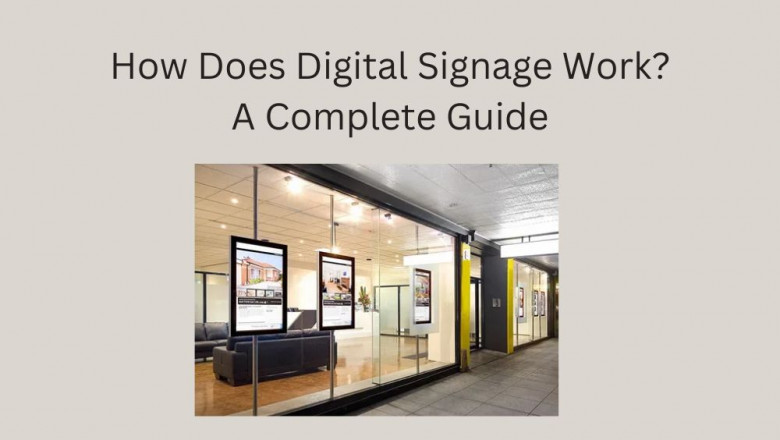views
Have you ever noticed digital screens displaying ads, menus, or announcements in malls, restaurants, or offices? That is digital signage in action. It is an effective way for businesses to communicate with their customers using digital displays like LED screens, kiosks, or video walls.
NOTE: Enhance your brand’s visibility and captivate your audience with cutting-edge digital signage in Dubai. Whether you need eye-catching displays for retail, corporate communication, or outdoor advertising, our innovative solutions help you deliver dynamic content with impact. Stay ahead of the competition and transform the way you engage customers
Digital signage helps businesses grab attention, share information, and enhance customer experience. But how does it actually work? In this guide, we will break down everything you need to know about digital signage in simple terms.
What Is Digital Signage?
Understanding the Basics
Digital signage is a form of electronic display that shows multimedia content such as images, videos, animations, and real-time data. Unlike traditional printed signs, digital signage allows businesses to update content instantly, making it more dynamic and interactive.
Common Uses of Digital Signage
Digital signage is used in many industries for different purposes, such as:
- Retail Stores – Display promotions, new arrivals, and discounts.
- Restaurants – Show digital menus, food images, and special offers.
- Hospitals – Provide directions, appointment schedules, and health tips.
- Corporate Offices – Share announcements, company updates, and welcome messages.
- Transportation Hubs – Show schedules, delays, and important travel alerts.
How Does Digital Signage Work?
To understand how digital signage works, let's break it down into four main components:
1. Digital Display Screens
The first thing you need is a screen to display the content. These can be:
- LED or LCD Screens – Common for indoor and outdoor advertising.
- Video Walls – A combination of multiple screens to form one large display.
- Interactive Kiosks – Touchscreen displays used for self-service.
- Projectors – Used in large events and exhibitions.
2. Digital Signage Media Player
A media player is a small device that connects to the screen and plays the content. Some screens come with a built-in media player, while others need an external one. The media player retrieves the content from the software and displays it on the screen.
3. Digital Signage Software
This is the control center for your digital signage. The software allows you to:
- Upload and manage content (images, videos, animations, etc.).
- Schedule when and where the content should play.
- Update content remotely from a computer or mobile device.
- Monitor screen performance and troubleshoot issues.
Some popular digital signage software includes Xibo, ScreenCloud, NoviSign, and Yodeck.
4. Internet or Network Connection
Most modern digital signage systems work over the internet, allowing businesses to control screens from anywhere. However, some systems work offline by storing content on a USB drive or internal storage.
Types of Digital Signage Displays
1. Standalone Digital Signage
- A single screen with built-in media player.
- Ideal for small businesses and indoor displays.
2. Networked Digital Signage
- Multiple screens connected through a network.
- Allows centralized content management.
- Suitable for large businesses and franchises.
3. Interactive Digital Signage
- Touchscreen displays that allow user interaction.
- Used in kiosks, self-checkout counters, and wayfinding systems.
4. Outdoor Digital Signage
- Weatherproof screens for outdoor advertising.
- Used for billboards, bus stops, and stadium displays.
Benefits of Digital Signage
1. Captures Attention Quickly
Bright, moving visuals are more attractive than static posters. Digital signage grabs attention and makes people more likely to engage with the message.
2. Easy Content Updates
With digital signage software, businesses can update content instantly without printing new posters. This saves time and money.
3. Boosts Sales and Engagement
In retail stores, digital signage influences buying decisions by showcasing promotions, discounts, and new arrivals.
4. Enhances Customer Experience
Interactive screens help customers find information, book services, or place orders without waiting in line.
5. Reduces Perceived Wait Time
Digital signage in waiting areas (hospitals, banks, airports) entertains customers with news, videos, or real-time updates, making the wait feel shorter.
How to Set Up a Digital Signage System
Step 1: Define Your Goals
Decide what you want to achieve with digital signage. Are you promoting products, providing information, or enhancing customer experience?
Step 2: Choose the Right Hardware
Select the appropriate screen size, resolution, and type (LED, LCD, kiosk, video wall) based on your needs.
Step 3: Select a Media Player and Software
Pick a reliable media player and user-friendly software that fits your budget and requirements.
Step 4: Create Engaging Content
- Use high-quality images and videos.
- Keep messages short and clear.
- Use eye-catching colors and fonts.
Step 5: Install and Test
Mount the screens securely, connect the media player, and test the system to ensure everything works smoothly.
Step 6: Monitor and Update Regularly
Check the performance of your digital signage regularly and update content based on audience response and business needs.
Future Trends in Digital Signage
1. AI-Powered Content Personalization
Artificial Intelligence (AI) is making digital signage smarter by displaying targeted content based on audience preferences and behaviors.
2. Integration with Social Media
Businesses are linking digital signage with live social media feeds to engage customers in real-time.
3. Augmented Reality (AR) and Virtual Reality (VR)
AR and VR technologies are being used to create immersive experiences in stores, museums, and events.
4. 5G-Powered Digital Signage
With faster internet speeds, digital signage will offer real-time content updates and better interactivity.
Conclusion
Digital signage is a powerful tool for businesses to engage customers, promote products, and share information in a dynamic way. With the right hardware, software, and content strategy, any business can take advantage of digital signage to enhance their marketing efforts.
Whether you own a small retail shop, a restaurant, or a large enterprise, investing in digital signage can help you stay ahead in the competitive market. Start today and make your business more visible, interactive, and customer-friendly














Comments
0 comment